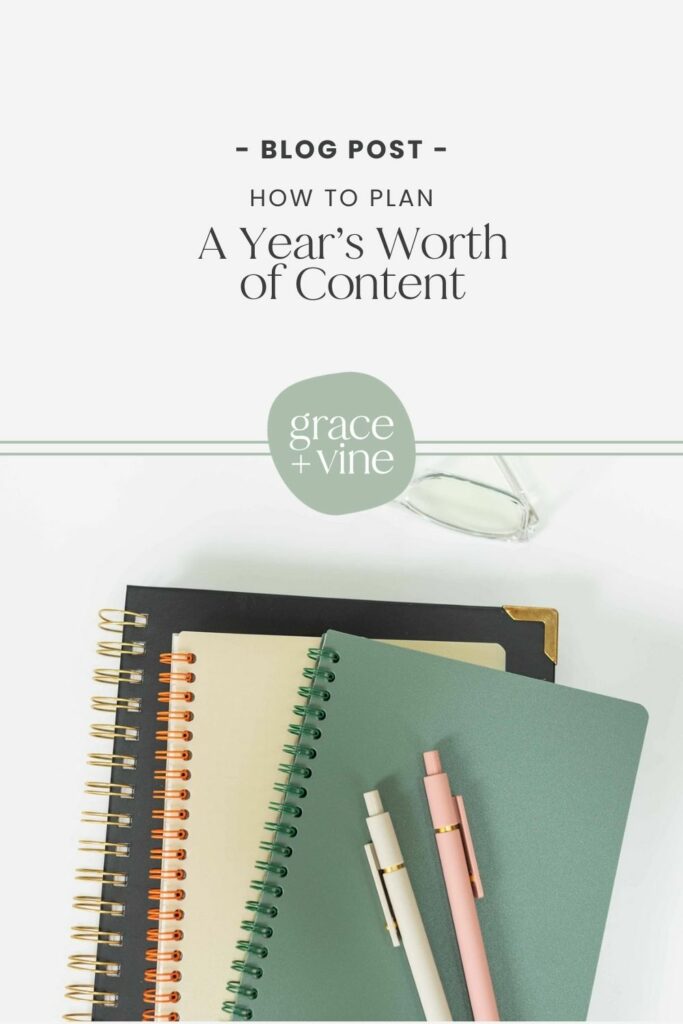Food blogging is a busy job — batch plan a year’s worth of content now, so you can focus on making the content and getting it out into the world. Once you remove the step of constant planning, you’ll feel more in control and have a better idea of what to work on, and when.

I hear from food bloggers a lot, “I need to plan next month,” or, “I’ve got to work on my Q1 plan,” — almost always at the last minute.
Like planning anything — a trip, a party, a week’s worth of meals — the more you can prep in advance, the less you’ll scramble to do later.
Once you have your plan for January, you can take on the whole year. At once.
Yes, I know. A year! It’s a long time, but trust me — you’ll feel amazing once you know exactly what you are doing all year long.
And it won’t be too hard — we just had the holidays, so those ideas for next year are fresh on your brain.
1. Set aside some time.
We talk a lot about batching content here, and I highly recommend it, especially for big planning projects. You’re going to need a few hours to make a yearly content plan, but you can spread it out over a few days or do it all in one sitting. You know yourself best, so do what sounds good.
I like to bring a print-out of a calendar to the table and scribble these things down, then I’ll transfer them to my content calendar later. You do you, though! A digital calendar works just as well, or you can have fun with sticky notes.
2. Figure out how many posts you need.
The first step is to figure out how many posts you’re planning to do per week and how many posts you plan to redo. Can’t decide?
- One a week is a good place to start! You can alternate between new and old content.
- If you can do two, do one new and one old per week.
Next, how many weeks will you post this year? How many weeks are you taking off (say, for vacations, the holidays, etc.)? If you do seasonal content, take it a step further. How many holiday posts do you want to do for each holiday of the year? Once you know those numbers, you can figure out how many posts you need.
For example, if you are planning 2 posts a week, and you’re taking 4 weeks off from blogging throughout the year, that’s 48 weeks x 2 posts each = 96 posts. I know that sounds like a lot. But you’re going to fill in those ideas in no time.

3. Gather your ideas.
You’ve done a content audit. You’ve done your keyword research. Pull out that list of ideas for new content. (If you’re anything like me, you have a bunch of notepads and notes on your phone to sort through. There is no shortage of ideas!)
If you haven’t done a content audit yet or need to do some keyword research, add some time for that in Step 1 or build in some extra time to do this as you plan. You don’t have to do a ton to get started!
4. Group your posts together.
Batching is also handy for photography and recipe development. When you can plan those batches out in advance and peter the content out throughout the year, you will always have content to share.
Start to group similar posts together and see what you can shoot at the same time. This could look like recipes that share similar ingredients, like beef meatballs and chicken meatballs, or recipes that could be plated together, like a cake and a frosting or a salad and a dressing. Like this:
Let’s say you have an old pasta sauce recipe you need to remake. You also have two new meatball recipes you want to make. And let’s say you’d like to do a post on garlic bread. You could shoot all of these things together, maybe even throw in some spaghetti to do a spaghetti and meatballs post. And potentially, you could even do posts on a meatball appetizer, tips on cooking spaghetti and garlic butter.
That’s — drumroll please — eight posts in ONE photo shoot. And you’re really only making one sauce, two kinds of meatballs, a loaf of garlic bread and a batch of spaghetti. You can photograph them together, maybe swapping out backdrops or props as you need to — but it’s a whole lot less mess than if you shot eight unrelated recipes at once.
You can absolutely do smaller batch shoots, too. But the more you can squeeze in, the more content you can create. Here’s another example:
Say you’re batching together a strawberry simple syrup and two drinks to make with it. Do you need to wash the strawberries? Cut the strawberries? Can you use the syrup on strawberry pancakes?
Now that simple shoot went from three posts to six. These info-type posts make great internal linking opportunities, and they’re easy to snap a few photos of while you’re making other things with those ingredients.
You can even batch recipes for different times of the year. Making turkey pot pie? Could you start with a Thanksgiving turkey or turkey breast recipe now, then cut the turkey you made to use in the pot pie?

5. Make your plan.
Once you have these groups, you can begin to plan out when you will post all these recipes. If you already have some things ready to go, plot those out on the calendar to get you started.
Be sure to add to your calendar when you plan to photograph these different batches, keeping in mind how often you will post, how long the shoot might take you, and build in some extra time in case things go awry. (Things often go awry! Ah, life.)
If you’re the kind of person who gets a bee in their bonnet to do some new great idea and you throw your plan away, maybe this year you should build in some *free spaces* (like in Bingo!) — these are days when you know you will post, but you’re saving some room for future creativity. This is totally okay! You don’t have to have an ironclad plan — just a plan.
Before you know it, you will have a full year planned ahead. And, with all those ideas, probably some of next year too!
Ready to take your blog to the next level? Get our blogger playbook!
Pin for later
Come browse my Pinterest for more inspiration >>






Leave a Comment